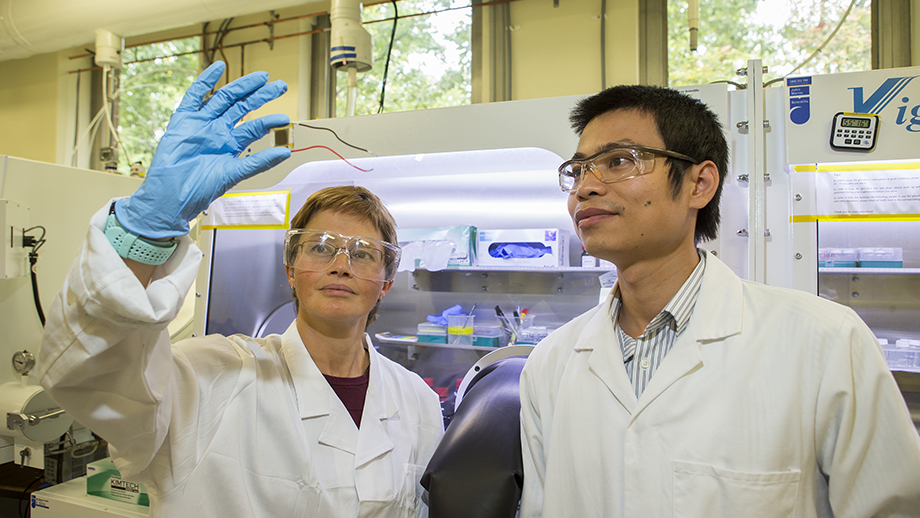Preovskite solar cells head for top
There is a new technology on the horizon for solar panels: perovskite solar cells. Professor Kylie Catchpole’s group at the Australian National University is researching the best ways to apply them, and make the most out of solar energy for our planet.
By Elizabeth Thomsen
The Sun provides an abundant, renewable source of energy. The amount of sunlight falling on Earth in an hour and a half is more than the amount of energy the whole world uses in one year.
However, to increase the uptake of solar energy it needs to be lower in cost. One way to reduce the overall cost per energy unit is to increase the efficiency of the solar panels.
Currently, 93% of the solar panel market is taken up by silicon solar cells. Silicon solar panels are typically around 17-18% efficient, and further efficiency improvements are becoming challenging.
There is a new technology on the horizon for solar panels: perovskite solar cells. Perovskite solar cells are formed from materials with a particular crystal structure which occurs naturally in certain minerals, but can also be simply and cheaply manufactured using different chemical elements. These manufactured perovskites can be used to make solar cells.
Perovskite solar cell efficiencies have risen from 3.7% in 2009 to 22.7% in 2017, making them the fastest advancing solar technology ever. The perovskite material in the solar cell is very efficient at absorbing sunlight, which means that only a thin film of material is needed, about the thickness of one-hundredth of a human hair. The solar cells can be manufactured in normal laboratories using low temperature processes (unlike silicon solar cell manufacture which needs a very low dust environment and high temperature processes).
However, there are still many challenges ahead for perovskite solar cells. Their performance is degraded by exposure to many everyday conditions such as ultraviolet light, oxygen, and heat. Researchers are working on boosting the cells’ resilience by improving the material, and encapsulating the solar cells to protect them.

Tandeming up
The huge market share occupied by silicon makes it hard for any new technology, such as perovskites, to compete. One approach, taken by Professor Kylie Catchpole’s group at the Australian National University, is to create a tandem solar cell with both a silicon and a perovskite component. The hope is that they will produce a premium product which will bring costs down further.
In tandem solar cells there are two cells, each of them absorbing part of the light from the sun. Each cell is selected to work best in a particular section of sunlight (for example visible light, or infrared light). The overall effect is that more of the sun’s light can be absorbed, and more energy is produced.
Typically, tandem solar cells are produced using expensive materials and manufacturing, and are mostly used in satellite applications, where their high power to weight ratio is desirable, or in concentrator systems, where sunlight is concentrated using mirrors or lenses onto a few, highly efficient cells.
However, by combining perovskite and silicon solar cells the group can leverage the dominance of the silicon market to produce a high efficiency cell with only a small increase in cost. So far they have produced a tandem cell which is 26.4% efficient. To do this, they stacked a perovskite cell on top of a silicon cell. The material in the perovskite solar cell was tweaked so that it absorbed visible light and was transparent to infrared light, which was then absorbed by the silicon solar cell.
After twelve hourly cycling between light and dark, the perovskite solar cell still retained 90% of its original efficiency, giving hope that such cells will be robust for use on rooftops, and in solar farms.
It is difficult to predict an upper efficiency limit for these tandem cells, but Professor Catchpole suggests that 38% is probably realistic. “In the near term we’d like to get over 30%”, says Professor Catchpole, something no silicon solar cell can achieve.
